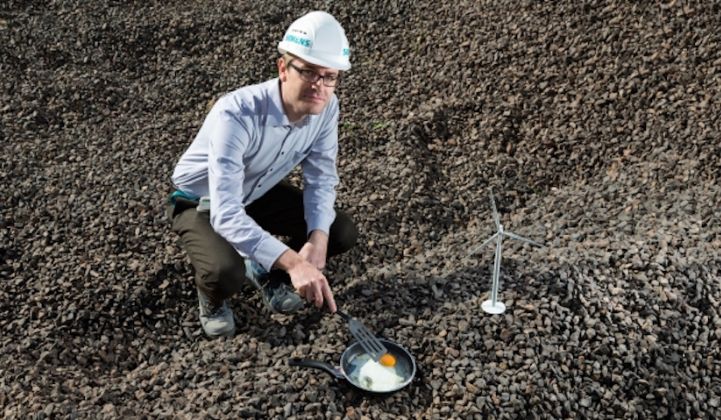Siemens believes a recently launched thermal storage concept for wind power could deliver energy at significantly below €0.10 per kilowatt-hour (USD $111 per megawatt-hour).
The cost would be for large-scale deployment of what Siemens is calling its "Future Energy Solution" (FES) and would depend on the exact nature of the storage application or applications involved, Till Barmeier, Siemens project manager, told GTM.
If achievable, the cost would beat U.S. gas peaker levelized energy costs of between $165 and $218 per megawatt-hour, as calculated by Lazard last year. It would also outdo other forms of storage analyzed by Lazard, including pumped hydro, with a lower limit of $188 per megawatt-hour.
Launched last month, FES is a mass storage concept that combines established steam turbine technology with packed-bed heat storage. Essentially, surplus electricity is used to power an industrial-scale heater that blows air at 600 degrees Celsius across a packed bed of basalt rocks in an insulated container.
When output is needed, the heat from the rocks is used to provide steam for a conventional turbine that delivers electricity back to the grid. Although the concept could in theory use electricity from any source, FES is specifically designed to take advantage of excess wind power.
Earlier this year it emerged that Germany curtailed about 1,581 gigawatt-hours of renewable energy in 2014, at a cost of €83 million ($94 million). Wind power accounted for 77.3 percent of all energy curtailed, representing 1,222 gigawatt-hours and more than $72 million.
The main attraction of FES is that it is based on proven technologies and a highly available and very cheap storage medium. Costs can be reduced even further by using existing decommissioned equipment such as steam turbines. "This is a reliable, low-cost solution," said Barmeier.
Siemens is currently assembling a 25-cubic-meter mock-up of the storage tank in the Bergedorf borough of Hamburg, Germany, with research funding from the German Federal Ministry for Economic Affairs and Energy.
The company plans to start testing the tank from this December and will then start work on a 5-megawatt, 36-megawatt-hour demonstration project, using a 1.5-megawatt Siemens steam turbine, on a disused aluminum smelter site in the Altenwerder container terminal quarter of Hamburg.
The demonstration project is scheduled for completion in early 2018 and will include a storage tank with 2,000 cubic meters of rock. It is planned to deliver up to 1.5 megawatts of power for up to 24 hours, with a round-trip efficiency of around 25 percent.
Local utility Hamburg Energie, a partner in the project along with Technical University Hamburg Harburg, will "investigate appropriate marketing options for the stored energy," according to a Siemens press release.
Barmeier said Siemens is planning to develop a commercial pilot project of between 30 and 40 megawatts in 2019 and is currently in discussions with potential customers.
Later full-scale commercial projects would likely have a capacity of 100 megawatts or more and be able to store up to 48 hours' worth of energy for as long as a week, with up to 50 percent round-trip efficiency.
The storage is likely to be modular, with Siemens investigating the optimum module size as part of its upcoming tests.
Other aspects of the concept earmarked for further research are whether FES plants should be located near wind farms or close to load centers, and how to create a base for the storage tank that can provide adequate insulation yet at the same time carry the weight of thousands of cubic meters of rock.
Aris Karcanias, managing director of FTI's Global Clean Energy Practice, said FES had plus points, but would have to measure up against the rapidly declining costs of other energy storage technologies.
"This technology operates on a set of simple principles with off-the-shelf, tried-and-tested technologies that can...achieve high system efficiencies at relatively low cost," he said.
"The technology, however, still has to prove itself in a market dynamic where electricity storage is becoming increasingly competitive and the ease with which battery storage systems can be deployed in high-value parts of the system poses a natural constraint for thermal systems,” Karcanias added.



